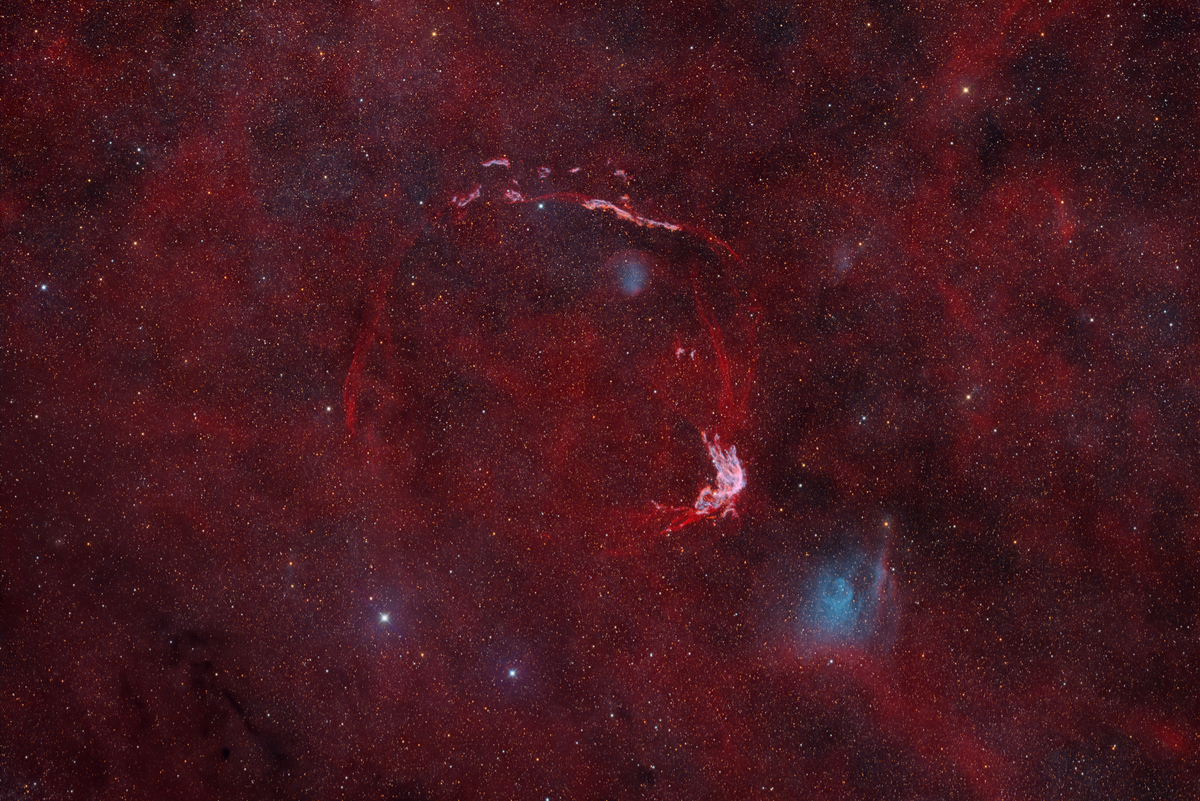Annotated version / Annotierte Version (9447 x 6303 pixel)

[back] RCW 86 (SN 185) in Circinus
Higher resolved image /
höher aufgelöstes Bild (9447 x 6303 pixel, 0.743
”/pixel)
Annotated version /
Annotierte Version (9447 x 6303 pixel)

|
5' |
|
(c) 2025 All astro photo images are copyrighted. They may not be used or reproduced without explicit written permission from the authors.
About this Image / Über dieses Bild
| Camera: | Moravian C3-PRO-61000 Mono CMOS |
| Image Type, Orientation: | RGB-SIIHaOIII Color Composite, North is at 12:00 |
| Exposure time: | RGB: 18/18/18 x 300s, SII: 20 x 900s, H-alpha: 20 x 900s, OIII: 19 x 900s (19:15h total) |
| Exposure date: | June 29th...July 28tht, 2025 |
| Location: | Capella Observatory South at Kiripotib Astro Farm, Namibia |
| Filter: | Astronomik Deep-Sky Deep-Sky RGB Filter plus 6nm SII, Ha, OIII filters on Moravian EFW-3L-9-II External Filter Wheel |
| Instrument: | "Rhea", a PlaneWave DeltaRho 350, 1050mm focal length, 350mm aperture, f/3 on 10Micron GM2000 HPS II Combi |
| Photographer: | Rainer Raupach, Josef Pöpsel, Frank Sackenheim, Stefan Binnewies |
| Remarks: |
RCW 86,
located on the border between the constellations Circinus and Centaurus,
represents the brightest part of the optical component of the supernova
remnant (SNR) of SN 185, which was observed in December 185 and documented
by Chinese astronomers. Recent investigations based on infrared (Spitzer,
WISE) and X-ray (Chandra) data have established that the event was a Type Ia
supernova [1]. Because the absolute magnitude of this type is highly
consistent, the apparent magnitude of the event — given its known distance
of roughly 9,000 light-years — can be estimated at about -4 mag at maximum
brightness. This is comparable to Tycho’s supernova of 1572. |
| Bemerkungen: |
RCW 86 an der Grenze der
Sternbilder Zirkel (Circinus) und Zentaur stellt den hellsten Teil der
optischen Komponente des Überrests der Supernova SN 185 dar, die im Dezember
185 beobachtet und von chinesischen Astronomen dokumentiert wurde. Aufgrund
von neueren Untersuchungen auf Basis von Infrarot- (Spitzer, WISE) und
Röntgen-Daten (Chandra) handelte es sich um eine Supernova vom Typ Ia [1].
Da die absolute Helligkeit dieses Typs sehr konsistent ist, kann die
scheinbare Helligkeit des Ereignisses bei dem bekannten Abstand von etwa
9000 Lichtjahren auf -4 mag im Maximum abgeschätzt werden. Dies ist
vergleichbar mit Tychos’s Supernova im Jahr 1572. |
| References: |
[1] Williams, Brian J.; et al. (October
2011). "RCW 86: A Type Ia Supernova in a Wind-blown Bubble".
The Astrophysical Journal. 741 (2): 96.
https://arxiv.org/pdf/1108.1207 [2] NASA/JPL-Caltech/UCLA: https://commons.wikimedia.org/wiki/File:RCW_86.jpg[3] IRAS/WISE data retrieved from https://skyview.gsfc.nasa.gov/current/cgi/query.pl[4] Gentle Fusillo N.P.; et al. (September 2021). "A catalogue of white dwarfs in Gaia EDR3". https://arxiv.org/abs/2106.07669 |
Back to the Supernovae-Remnants Overview / Zurück zur Supernovae-Überreste-Übersichtsseite